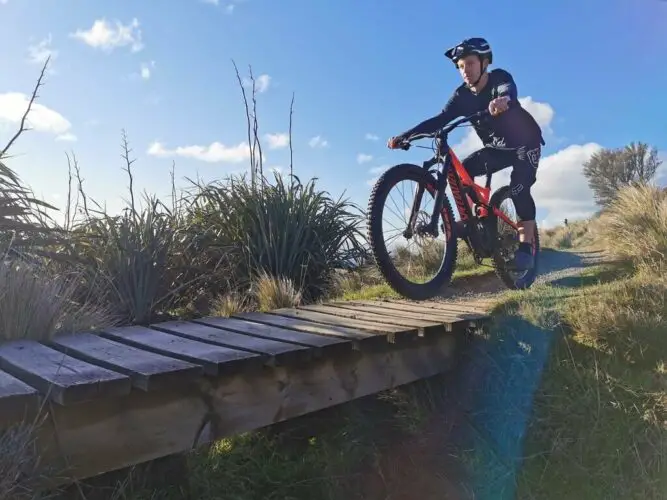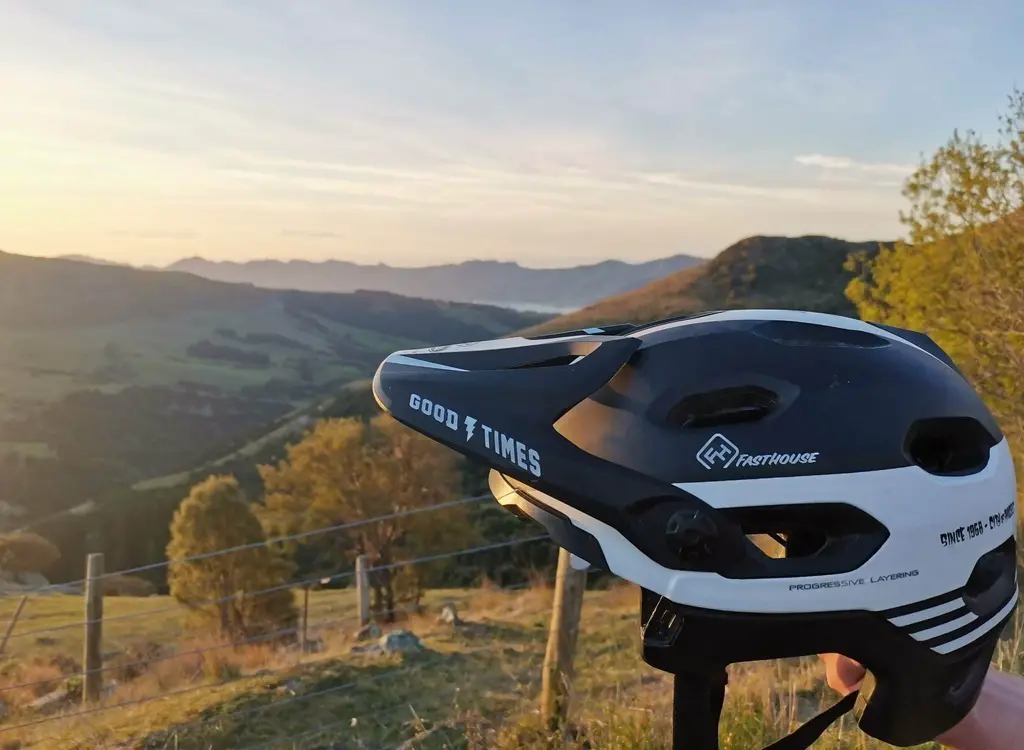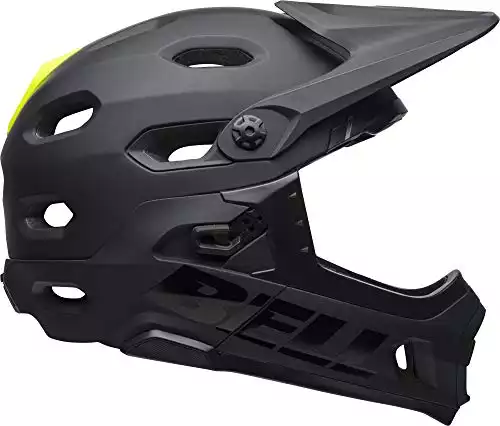This Bell Super DH review explains the pros and cons of the mountain bike helmet and whether it is the right choice for you.
Convertible helmets have taken the mountain biking world by storm in recent years. The option of having two excellent helmets for the price of one is just such great value.
The Bell Super DH is more than just a trail bike with a chin bar attached. It stands out as it is downhill certified- meaning it can handle a bit more impact than a regular helmet can.
The Super DH is the ideal helmet for essentially anyone. It is a safe and practical helmet for beginners, a good trail riding or intermediate helmet, and the perfect helmet for enduro riders.
What makes a good convertible helmet?
A quick overview on what to look out for when buying a convertible helmet.
Safety
Helmets are rated based on how safe they are considered. This involves testing the helmet in a lab to see what kind of force it can dissipate safely. All helmets must pass a baseline test before they can be sold in stores.
Some helmets go a few steps further to achieve the ‘downhill certification’ (ASTM 1952). If a helmet has is downhill certified, it can handle larger forces and hence is more suitable for hardcore downhill riding.
A must-have in a helmet is a rotational impact and concussion prevention system, such as MIPS or SPIN or Turbine 360. The foam inside a helmet will reduce the energy from linear impacts, while these systems will prevent angular forces impacting your brain- hence reducing the chances of concussion. The combination of the two (foam and anti-rotational technology) will keep your skull and brain safe in a crash.
Comfort
As safe as a helmet is, it won’t keep your head safe if you aren’t wearing it due to discomfort! A comfortable helmet can make all the difference to your riding as well. If you barely notice it is there then you have found a winner!
Weight & Ventilation
Putting on a heavy and hot helmet is never inspiring. A lightweight trail helmet weighs around 350g, while a heavy one would be around 500g. In terms of full face lids, I wouldn’t want to ride far in a helmet weighing over 1000g. A full face, such as the Bell Super Air R, weighs around 750g which is pretty light!
Ventilation is a hard one to assess without trying out the lid. Just looking at the number of vents won’t determine whether it is well ventilated or not. Overbrow ventilation and MIPS Spherical help with getting the air through the helmet.
Bell Super DH Review
Bringing together the best of both worlds, a detachable chin bar makes for an easy climb and a safe descent. For the price of one, you get a top-of-the-line open face helmet and a fully certified downhill helmet that is comfortable, durable, and easy to use.
Pros
- MIPS Spherical
- Downhill certified
Cons
- Relatively Heavy
- Ventilation isn’t great
Who is it for: For the safety conscious beginner, through to experienced enduro riders. Not for long distance riders though!
Comfort and Fit
If you have ever encountered a helmet that sits all wrong on your head, causing one part of the head to feel a bit squashed by the time you get the helmet off, you will know the importance of comfort and fit of a helmet.
The Bell Super DH is like a cloud on your head. The padding is plush, placed right the way around the head. The Float Fit system (by Bell) tightens using the rubber-covered dial at the rear of your head. The system tightens in small increments, evenly around your head. You won’t end up with any pressure points, and you can always get the right level of security. The dial is easy to adjust, even while riding and with gloves on.
As a full face, the padding is again thick and soft. The pads sitting against your face are so comfortable you never really want to take the chin bar off. The pads are also adjustable, so you can switch out too much or too little padding for some thicker or thinner pads (spares come in the box).
Unfortunately, however, it isn’t the lightest of helmets on the market. For a long distance ride (ie: multi-day or 80 km+) I find myself reaching for my lighter-weight trail helmet (Giro Source). However, if you compare it with dedicated full face helmets, the Super DH is no heavyweight. It weighs in at 850 g with the chin bar, making it seem breezy when compared to the Fox Rampage, the POC Coron Air SPIN or the 100% Aircraft 2, which all weigh over 1000g.
Safety
The Super DH stands out in the convertible helmet range because of the level of safety it offers. It is already a step above the standard half shell in terms of protection, as it has the addition of the chin bar if needed.
The Super DH has MIPS Spherical which is the latest (and greatest) generation of MIPS protection. Instead of having the plastic helmet liner inside the shell, the MIPS spherical essentially has two layers of EPS foam. These two layers of foam can rotate separately to one another, providing resistance to rotational forces without impacting your head. Having the additional EPS shell also provides an extra bit of impact protection from direct impacts.
MIPS Spherical is constructed of two layers of different densities of EPS foam. The inner layer (which most helmets are constructed of) is softer, allowing the material against your head to crush slightly easier which is a bit gentler on your skull. The outer layer is a denser material, which absorbs the energy from the solid ground.

As a full face helmet, it meets the ASTM 1952 (downhill) certification (as well as the CPSC bicycle standard). It is nice knowing that the helmet you are wearing can withstand a bit more force than helmets that don’t have this certification.
Chinbar Attachment System
The removable chin bar attachment on the Bell Super DH MIPS doesn’t take long to get used to. I find myself taking the chin bar off at any chance I can get- chatting to mates, having some food- and I can quickly click it back into place when I am done.
To get the chin bar attachment on, you slot the front of it into the slots on your helmet up by your cheek bone. Once those are in, you push the side of the attachment into the holes on the side of the helmet, and secure the latch.
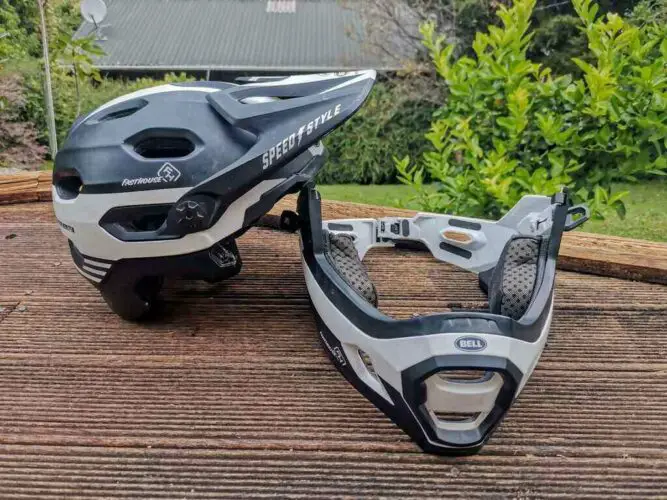
It is a little clunky when compared to the magnetic chin bar release that can be found on the MET Parachute MCR. The latch may need a little refining by Bell, but it’s also nowhere near the worst either.
In full face mode, it is easy enough to take the chin bar off with the helmet on your head. And if you got good enough, you could probably learn to clip it back on with the helmet still on your head! You would need someone to check that the clips are secure though, as it is not immediately obvious.
Ventilation
Bell has done its best at making the Super DH be as ventilated as possible without sacrificing on safety aspects. The MIPS Spherical claims to be better ventilated that the plastic liner of the more basic MIPS system. The air is able to enter through the overbrow vents and flow through the two foam layers of the helmet, keeping the air cool.
The Super DH has X vents, allowing the cool air to cycle through the helmet, and prevent you getting too warm.
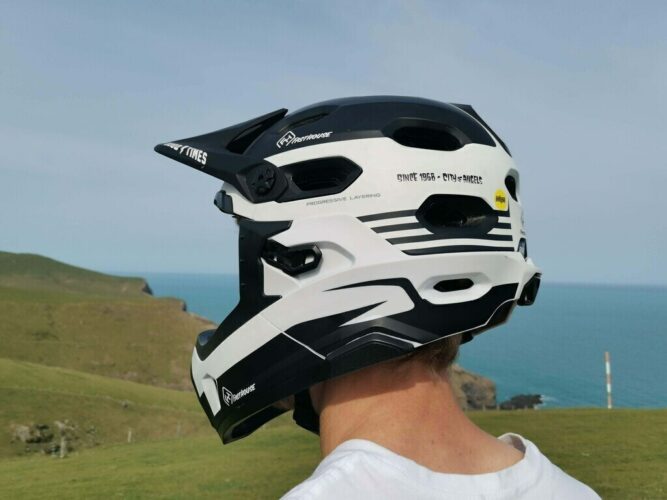
Still, it is certainly not the best ventilated helmet on the market. You will definitely notice the difference if you have previously been riding with light and breezy helmets such as the likes of the Specialized Ambush or the Giro Montaro.
The X Static padding does a great job at wicking away the sweat on long rides. And if you combine that with the sweat guide, which draws the sweat away from your face, you won’t be getting in a river of sweat running down your face!
Visor
The visor is the ideal length for a convertible helmet. It is not too short as a full face, nor are you left with a overly long visor as a half shell.
Bell’s Goggle Guide adjustable visor allows you to store your goggles or glasses on the helmet, below the visor for climbs or when ever you don’t need them.
The visor is designed to breakaway in the event of a crash. The idea is to prevent the neck from bening bent at awkward angles, so the visor will pop off if it comes under force. The replacement visors can be found easily and cheaply.
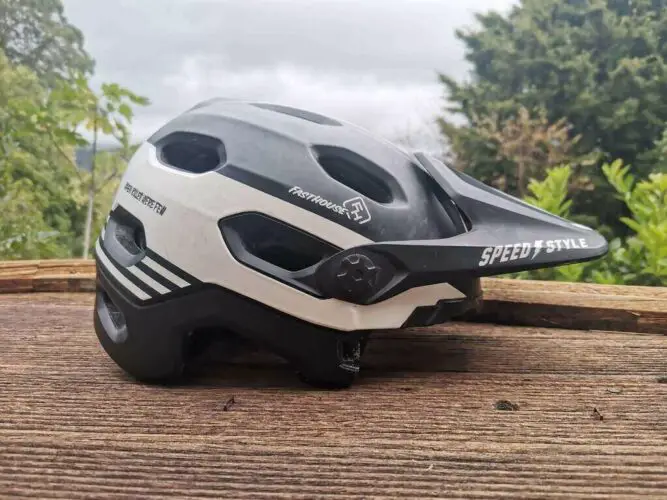
Durability
Having used this helmet almost on a daily basis for a number of years, I can confirm the Bell Super DH is certainly going to stand the test of time (note that a helmet will have an expiry date however).
The polycarbonate outershell fully wraps around the shell of the helmet, protecting the inner EPS foam liner. This prevents branches, rocks or anything tearing at the foam, allowing the helkmet to last longer.
The latches connecting the chin guard to the helmet are sturdy, and have not worn out in the two years I had been using this helmet almost daily.
Bell helmets are well known for quality, and I have no concerns for the durability of this helmet.
Comparison and Price
It is bigger and burlier than both of Bell’s other downhill lids, the Bell Super 3R and the Bell Super Air R. This means it’s heavier, and a little less ventilated. But, the Super DH is downhill certified, while the other two helmets are not.
The Super 3R and Super Air R are ideal for trail riders who don’t send it down gnarly trails on a regular basis. The DH would be the helmet I would take for big days at the bike park, while I would reach for the other two for a trickier section of trail at the local park.
MET Parachute MCR is similar to the Super DH. It is downhill certified, detaches just above the ears, and is priced pretty similarly. However, it is lighter and better ventilated. It has a quicker, less clunky chin bar connection system than the DH, using a magnetic chin bar release (MCR) system. However, it does NOT have MIPS Spherical, which is enough to convince many riders to go with the trusty Bell helmet over the Parachute.
For a full comparison between the convertible helmets on the market, check out this post.
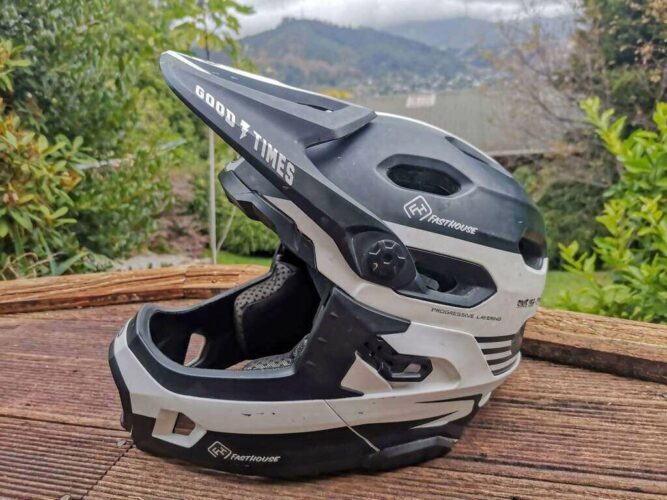
Features
- MIPS Spherical
- ASTM1952 Helmet rating
- Fidlock chin buckle
- Removable and spare cheek pads
- Breakaway action camera mount
- Adjustable visor
- Goggle Storage
Final Thoughts
The convertible helmet is really taking off due to its unparalleled versatility. I have certainly been converted, and don’t see why I would ever go back to having two separate helmets! The convertible helmet is ideal for anyone who wants a little more security on more difficult tracks, and a lighter helmet for trails- without having to purchase two separate helmets.
While the Bell Super DH is an excellent trail helmet, it is also very much for those wanting to fit in bike park laps too.
If you are looking for a helmet with DH certification (ASTM F1952), the Bell Super DH will be one of your best bets.
